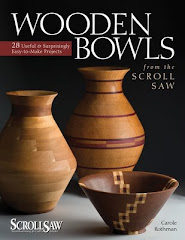I came across a post on the scroll saw forum that mentioned a recent video review of my box book by Steve Ramsey, who has a very active and popular woodworking site. Of course I had to take a look, and I was tickled by his enthusiasm about the projects. It was interesting that he assumed that the projects required a high skill level, which they really don't. Since my primary aim in designing projects is for them to be fun to make, give and receive, I was really pleased by his response.
The review is somewhere in the middle of the video. If you're curious, take a look. I'd never heard of him, but apparently he's been around a while. And of course I'm grateful for anything that helps get the word out about my work!
Sunday, October 28, 2012
Wednesday, October 17, 2012
A new use for the Hegner
We're still trying to figure out whether to put the shop in the garage or basement, comparing set-up costs, convenience, etc., so it will still be a while before I can get down to some serious work.
However, that doesn't mean we don't need to have usable tools. Today's project was to convert a single mailbox stand to one that can hold two mailboxes (Post Office regulations--don't ask!). The only accessible saw was the Hegner, so we plugged it into the garage opener outlet and I made the needed cuts. Hardly precision work, but shows how versatile the scroll saw can be. Fortunately, I had some heavy-duty blades on hand, and was actually able to find them amid the mess. As you can see, we have a way to go, but we're getting there, little by little.
However, that doesn't mean we don't need to have usable tools. Today's project was to convert a single mailbox stand to one that can hold two mailboxes (Post Office regulations--don't ask!). The only accessible saw was the Hegner, so we plugged it into the garage opener outlet and I made the needed cuts. Hardly precision work, but shows how versatile the scroll saw can be. Fortunately, I had some heavy-duty blades on hand, and was actually able to find them amid the mess. As you can see, we have a way to go, but we're getting there, little by little.
Labels:
Hegner,
mail box,
scroll saw,
woodshop
Monday, October 8, 2012
Photographing your work
Whether you're submitting your work to a magazine, posting to a blog, or just sharing with a friend, a little attention to detail can produce a photo that does justice to your work. Here are a few tips:
First, be sure that the background is not distracting. A seamless background can easily be made using a table placed against a wall, and a sheet of poster board. Prop the poster board against the wall lengthwise, with about half resting on the table. This should give you sufficient area to completely surround the project.
Be sure the picture is in focus. Unless you have a steady hand, or your camera has an "anti shake" feature, use a tripod or some other way to stabilize the camera.
Use natural lighting if possible. If you must add light, position the lighting on both sides of the project to prevent shadows. If you are using only one source, try moving the light until you're satisfied. If shadows are an issue, try draping a handkerchief or thin cloth over the light.
And finally, take pictures from different angles. You can do this by rotating the project or by moving the camera. Upload them to your computer for a closer look, and to "tweak" them, if needed, with editing software.
First, be sure that the background is not distracting. A seamless background can easily be made using a table placed against a wall, and a sheet of poster board. Prop the poster board against the wall lengthwise, with about half resting on the table. This should give you sufficient area to completely surround the project.
Be sure the picture is in focus. Unless you have a steady hand, or your camera has an "anti shake" feature, use a tripod or some other way to stabilize the camera.
Use natural lighting if possible. If you must add light, position the lighting on both sides of the project to prevent shadows. If you are using only one source, try moving the light until you're satisfied. If shadows are an issue, try draping a handkerchief or thin cloth over the light.
And finally, take pictures from different angles. You can do this by rotating the project or by moving the camera. Upload them to your computer for a closer look, and to "tweak" them, if needed, with editing software.
Labels:
digital camera,
photography,
poster board,
woodworking
Subscribe to:
Comments (Atom)






